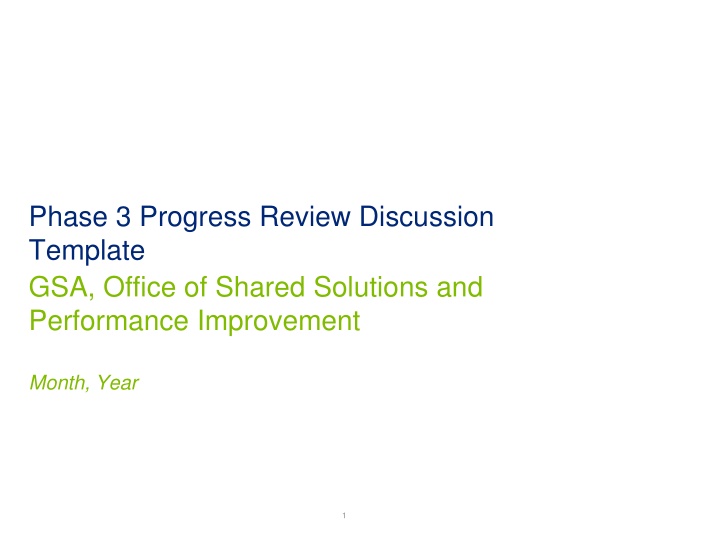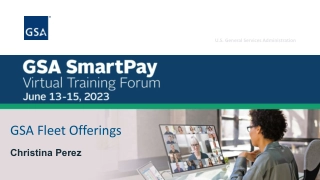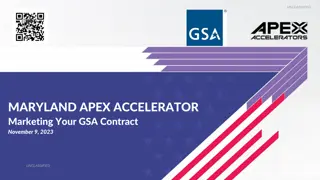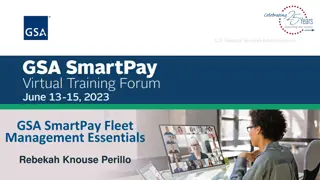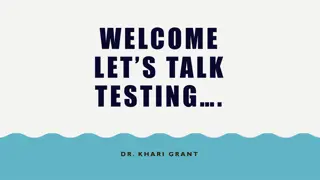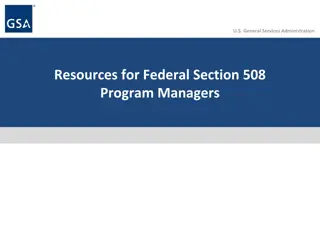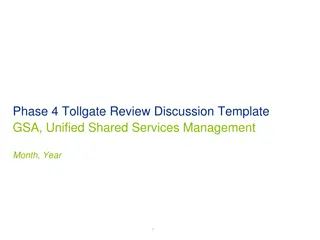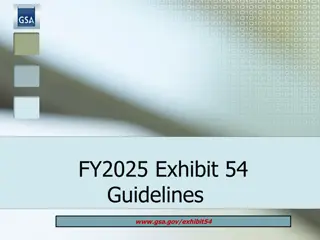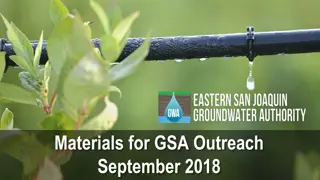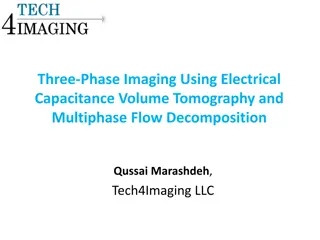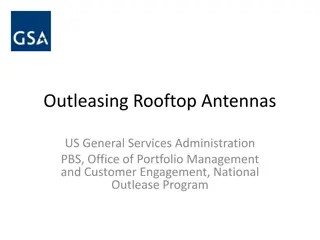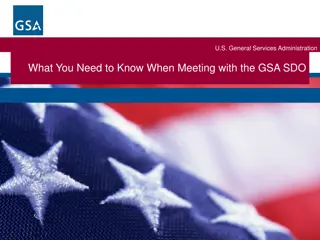Phase 3 Progress Review Discussion Template - GSA Office of Shared Solutions
This template is designed to facilitate a progress review discussion involving customers, providers, and key stakeholders. It includes questions related to fit-gap analysis, risk analysis, resource readiness, schedule feasibility, service scope definition, and more. The template guides users on completing the review, discussing specific questions, and scheduling a meeting.
Download Presentation

Please find below an Image/Link to download the presentation.
The content on the website is provided AS IS for your information and personal use only. It may not be sold, licensed, or shared on other websites without obtaining consent from the author.If you encounter any issues during the download, it is possible that the publisher has removed the file from their server.
You are allowed to download the files provided on this website for personal or commercial use, subject to the condition that they are used lawfully. All files are the property of their respective owners.
The content on the website is provided AS IS for your information and personal use only. It may not be sold, licensed, or shared on other websites without obtaining consent from the author.
E N D
Presentation Transcript
Phase 3 Progress Review Discussion Template GSA, Office of Shared Solutions and Performance Improvement Month, Year 1
Questions to be Answered This template is intended to guide a Progress Review discussion between a Customer, Provider and Key Stakeholders. Questions to Be Answered Are the fit-gap analysis results in alignment with maintaining standard solutions to the extent possible? How inclusive is the risk analysis? How inclusive is the integrated master schedule? Is the schedule realistic and achievable? Is the selected provider adequately resourced and prepared to support the new customer in the migration phases? Is the customer adequately resourced and is the organization ready to begin the migration phase? Are the scope of services and migration phase roles and responsibilities adequately defined and understood between customer and provider Are service level agreements adequate to maintain performance requirements? Does the program have adequate plans to mitigate key risks and issues? 3. Engagement Has the Life Cycle Cost Estimate (LCCE) been updated to reflect business requirements, and is it reasonable? 2
Instructions for Completing This Template This template is intended to guide a Progress Review discussion between a Customer, Provider and Key Stakeholders. To use this template: Use the source documents included within each slide to develop summary-level information that will help guide the Progress Review Be prepared to discuss specific questions/content included on each slide before or during the Progress Review Once complete, schedule a Progress Review meeting 3
Documentation Required for Phase 3 Progress Review The following documentation is required in guiding a discussion to demonstrate readiness and gain approval for Phase 3. Agencies purchasing transaction processing services only will identify relevant activities and artifacts for their project using the M3 Services Tailoring Guide. Phase 3 Documentation Information Contained in Progress Review Discussion Acquisition Strategy Business Readiness Assessment Business Needs Workbook Change Management Plan Change Readiness Assessment Change Request Form Change Request Log Communications Plan Configuration Management Plan Contact Center Strategy CooP and Disaster Recovery Plan Data Cleansing Plan Data Cleansing Scripts Data Conversion Plan Decommission Plan Documented Data Structure and Mapping Enhancement Strategy Go/No-Go Criteria for Go-Live Assessment Governance Plan Implementation Approach/Schedule Independent Verification & Validation (IV&V) Plan Integrated Master Schedule (IMS) Interface Strategy Labor Relations Strategy M3 Risk Assessment Tool Migration Approach, including Technical Strategies Migration Plan Service Level Agreements (SLAs) Program Charter Program Management Plan Quality Assurance Surveillance Plan (QASP) Requirements Fit-Gap Analysis Requirements Management Plan Requirements Traceability Matrix (RTM) Resource Management Plan Risk Management Plan Risks, Actions, Issues, and Decisions (RAID) Log Stakeholder Analysis Status Reports/Dashboards Target State Concept of Operations Target State Systems Environment Technical Strategy Test Plan Training Plan Validated and Updated As-Is Systems Environment Workforce Assessment Acquisition Strategy (Customer) Acquisition Strategy (Provider, Federal) Change Management and Communications Approach Contact Center Approach Data Management/Data Quality Approach Lessons Learned M3 Risk Assessment Tool Migration Plan, Schedule, and Release Approach Program Governance Model Requirements Fit-Gap Analysis Resource Management Plan (Customer) Resource Management Plan (Provider) SLAs Target State Solution Scope Top Risks Training Approach Exit Criteria (to move into Phase 4) Fit-Gap Analysis Completed Go/No-Go Criteria Approved Integrated Master Schedule Drafted Migration Approach Finalized PMO and Governance Process Integrated SLAs 4
M3 Risk Assessment Tool Determine the risk rating at the end of Phase 3 using the M3 Risk Assessment Tool and submit with progress review material. 5
Target State Solution Scope Describe the Target State Systems Environment based on the scope of the migration. Consider providing an overview and a diagram of the following: The systems that will be managed by the provider The customer or third-party systems that will be impacted by the migration Other transformation or implementation initiatives that need to be coordinated in parallel Any new or impacted interfaces Source Documentation from Playbook Target State Systems Environment 6
Requirements Fit-Gap Analysis Provide a description of the major gaps identified, the associated gap solutions, and the impact to the implementation Consider including the following: Mandatory or mission-critical gaps and the categories they fall in The largest gap areas, and the plan to fill these gaps Source Documentation from Playbook Requirements Fit-Gap Report 7
Migration Plan, Schedule, and Release Approach Provide a description of the major elements of the implementation approach including key dependencies Consider providing a description of: The approach and schedule for releases The critical path milestones and dependencies that must be achieved for a successful migration The approach and schedule for data conversion, testing, and retiring legacy systems Source Documentation from Playbook Integrated Master Schedule Implementation Approach/Timeline 8
Top Risks Provide the top 5 10 integrated migration risks identified to date by the customer and provider and proposed mitigation strategies Risk Impact Probability Owner Mitigation Strategy <Dedicate additional resources to support data cleansing efforts no later than 4/20> <Risk 1: If adequate resources are not dedicated to data cleansing, then cleansing activities will be delayed and the quality of the conversion will be reduced> High Medium Program Manager Source Documentation from Playbook Risks, Actions, Issues, and Decisions (RAID) Log Risk Management Plan 9
Resource Management Plan Update (Customer) Provide an Organization Chart and indicate required number of full time equivalents (FTEs)/resources, existing resource gaps, and plan to fill resource gaps Consider including the following: The roles and responsibilities needed for the customer migration team for Phase 4 Total number of resources needed and total number of resources staffed The percentage of time required for each position on the customer migration team Vacant positions and plan to fill each position For each role, indicate if resources are in an acting in an acting, detailed, or contractor-filled position Source Documentation from Playbook Resource Management Plan 10
Resource Management Plan Update (Provider) Provide an Organization Chart and indicate required number of full time equivalents (FTEs)/resources, existing resource gaps, and plan to fill resource gaps Consider including the following: The roles and responsibilities needed for the provider migration team for Phase 4 Total number of resources needed and total number of resources staffed The percentage of time required for each position on the provider migration team Vacant positions and plan to fill each position For each role, indicate if resources are in an acting in an acting, detailed, or contractor-filled position Source Documentation from Playbook Resource Management Plan 11
Acquisition Strategy (Customer) Provide the details around planned and awarded procurements to support the migration Consider including planned and awarded procurements, including the provider Requests for Proposal (RFPs) (Commercial only) using the table below: Expected Period of Performance Planned Procurement (including Scope) Acquisition Strategy Planned Contract Value Expected Award Date Status* Data Conversion: Provide services to extract and translate data from legacy application *Statuses may include: Early Planning, Requirements Defined, RFP Released, Award Complete Source Documentation from Playbook Acquisition Strategy 12
Acquisition Strategy (Provider, Federal) Provide the details around planned and awarded procurements to support the migration Consider providing planned and awarded procurements using the table below: Expected Period of Performance Planned Procurement (including Scope) Acquisition Strategy Planned Contract Value Expected Award Date Status* Data Conversion: Provide services to extract and translate data from legacy application *Statuses may include: Early Planning, Requirements Defined, RFP Released, Award Complete Source Documentation from Playbook Acquisition Strategy 13
Change Management and Communications Approach Describe the approach and strategy for change management, communications, and stakeholder management Consider providing updates to the following: The stakeholders that will be impacted by the migration The change management activities that are planned for the program lifecycle with activity owners for the following: Business Process Re-engineering Communications Workforce Alignment Source Documentation from Playbook Communications Plan 14
Training Approach Describe the program s training approach including delivery method, schedule dependencies, and post Go-Live support Consider including information on: Training roles and responsibilities between the customer and provider The curriculum, delivery method(s), and number of end users to be trained for each topic The approach to post-Go-Live support (e.g., refresher training offered by provider, centrally stored recorded trainings) Source Documentation from Playbook Training Plan 15
Help Desk Approach Describe the help desk strategy for Operations and Maintenance (O&M) Consider providing an overview of the following: The services that will be acquired from the provider for help desk support The strategy for tiering help desk support The approach to escalating inquiries, incidents, and issues Source Documentation from Playbook Integrated Help Desk Plan 16
Data Management/Data Quality Approach Provide an overview of the data management and quality approach including an overview of findings from the initial data assessment Provide updates to the following: The results of your data quality assessment Data cleansing activities that have already begun The timeline for future data cleansing activities Success criteria used to measure data quality Source Documentation from Playbook Data Governance Model Data Cleansing Plan 17
Integrated Program Governance Model Describe the integrated program s governance model Consider providing the following: The governance structure, which identifies the roles, responsibilities, and which offices are represented A description of integration points between customer and provider governance groups The process, cadence, and timeline to make decisions The process and criteria used to escalate decisions, issues, and risks Source Documentation from Playbook Governance Plan 18
Lessons Learned Describe the overall lessons learned from the Engagement Phase Consider providing an overview of: What worked well during the phase What could be improved during future implementations Recommendations to be incorporated for the Migration phase Source Documentation from Playbook Lessons Learned Report 19
Next Steps Please describe the activities planned for the next 30, 60, and 90 days 20
